#East Gateway of Suzhou
Text
21 crazy buildings in China
New Post has been published on https://china-underground.com/2012/11/20/21-crazy-buildings-in-china/
21 crazy buildings in China
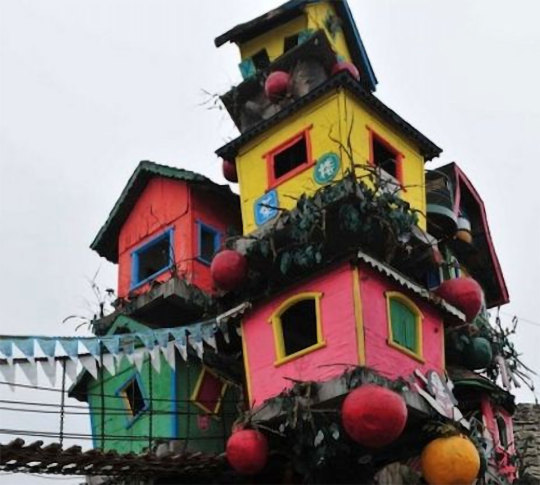
Chinese website 163.com compiled a gallery of the 21 craziest buildings built in recent decades in China.
In recent years, cities’ urban development become a hot topic because these constructions are related to a large amount of money. Many times, mainly because constructors and local authorities distinguish these buildings from classic skyscrapers, they present whimsical shapes, which also lead to an increase in construction costs.
In this gallery, there are public buildings, Chinese private companies buildings, and also copycats of famous western architectural designs.
The weirdest buildings in China
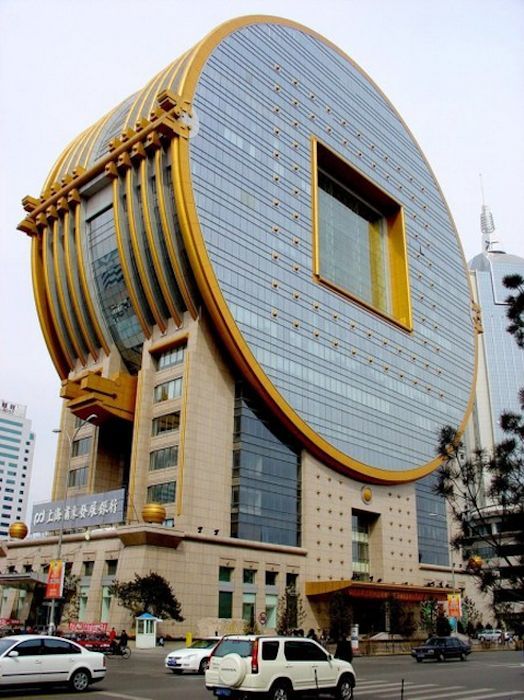
Shenyang Finance and Trade Development Zone, and in particular the building of Fangyuan Mansion. This building with a cylindrical shape was designed like a coin because the owners work with money. On 10th January 2012, CNN classified the structure in the top ten of the ugliest buildings in the world. The building was designed by renowned Taiwanese architect CY Lee designer of the Taipei 101 Tower. CNN reported that Fangyuan Mansion tries to merge Eastern and Western styles, but this merger has not a harmonious appearance.
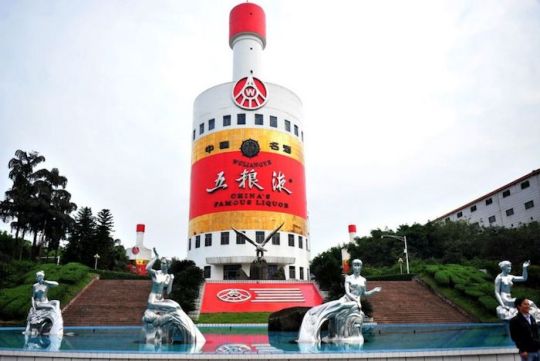
Cuiping Wuliangye, Yibin city, Sichuan Province, a company’s factory that produces liquor has a building shaped like a bottle.

Yiling, District of Yichang City, in Hubei Province, the offices of a local group is located in a building shaped like a bottle.

On 15 December 2009, in Hebei, Yanjiao, was opened the most shocking hotel: the Hotel of the Emperor, with the appearance of three gods. The structure of 41.6 meters in height has been designed in 2001. The hotel is classified as “the largest pictographic building” and therefore entered the Guinness Book of World Records as the best project, the largest in the world which is both a sculpture and a building.
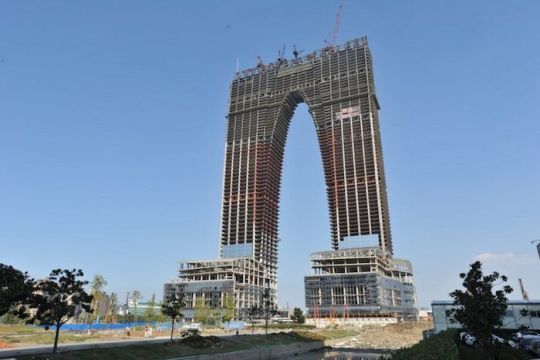
Many Chinese Internet users have expressed their disapproval of “the East Gateway of Suzhou” structure still under construction.
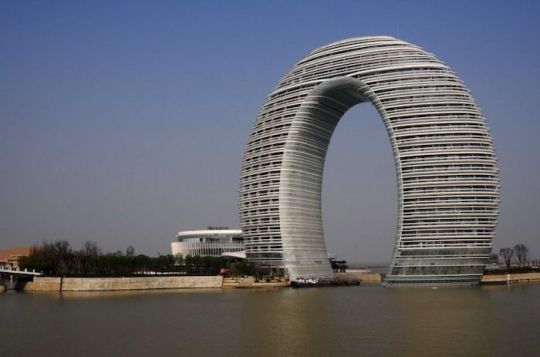
The list included also Taihu Pearl – China Huzhou Sheraton Haikou Resort.
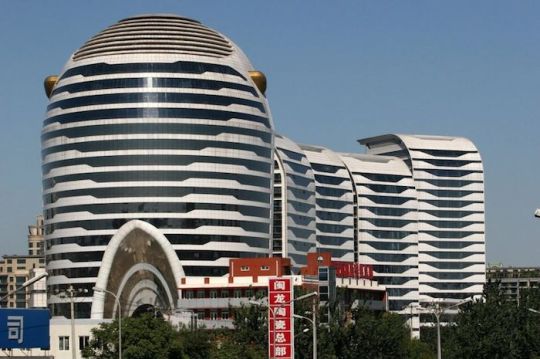
Exterior design of the building Linda Hai Square with the shape of fish wasn’t appreciated; located on Dongsi ring.

Sanya, Hainan Island. “Phoenix Island Real Estate” sells apartments t an average price of 90,000 RMB per square meter.
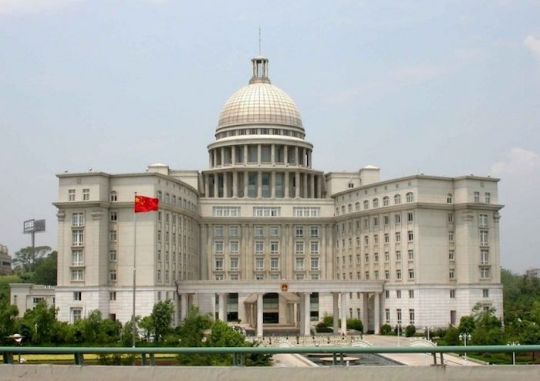
Nanjing, Yuhua. The government building is similar to the Capitol in Washington DC.
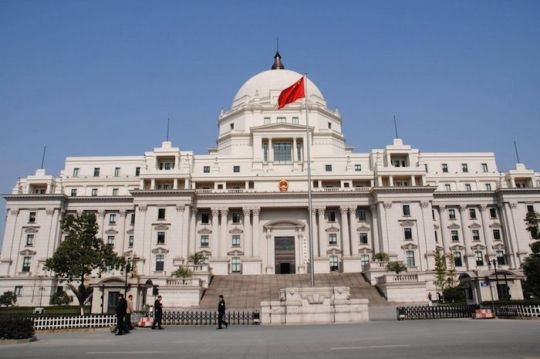
A Wenling People’s Court Building is similar to the White House.
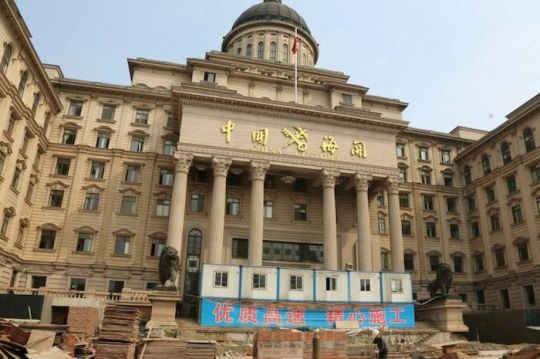
The second ring road east of Changsha, Hunan Province, the customs office resembles the U.S. Capitol.

In Fujian, Fuqing was built in Lin Yi Park an “Eiffel Tower” tower renamed Tiancheng.

In Jiangsu province, Funing County, Seongnam, in the park White Swan has created a cottage reminiscent of Sydney Opera House Swan Harbor.
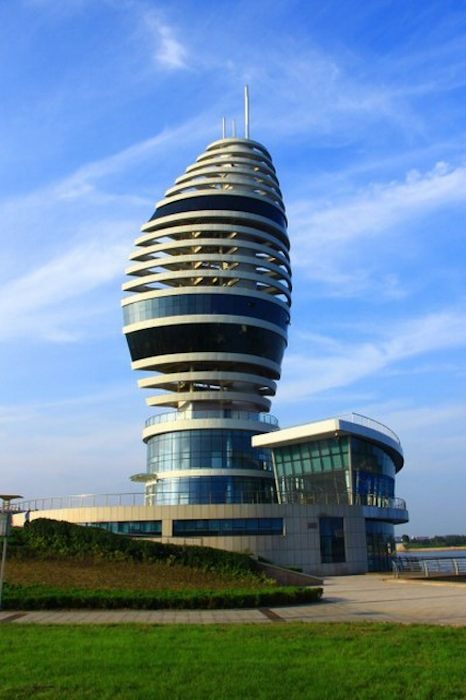
Shandong Rizhao water tower is called “Sail of the Century”.

Chongqing, Guotai Art Center, Center of Bashu Culture Art, which will be completed later this year. CFP

Henan province, Yichuan, netizens have reported that the project of the north gate of the city looks like a belt.

Beijing Olympic Park watchtower, still under construction, consists of five independent towers with different heights: the main tower reaches a height of 244.35 meters. Many have compared the structure of five big “pins.”

Located in the south-east of Beijing, on the fourth road ring, Zhuoen Sen Oriental.
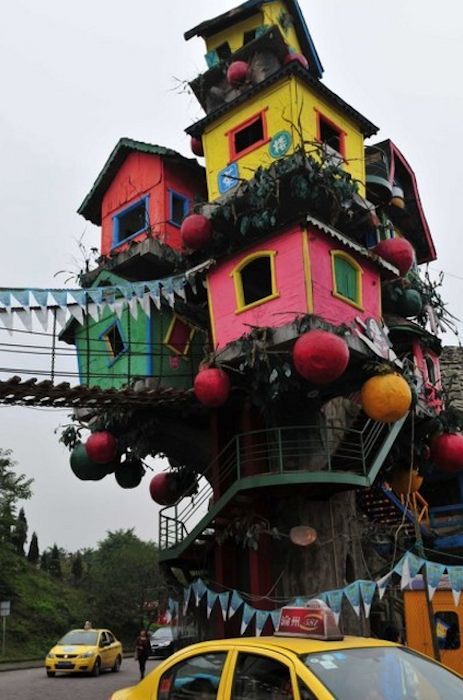
Chongqing
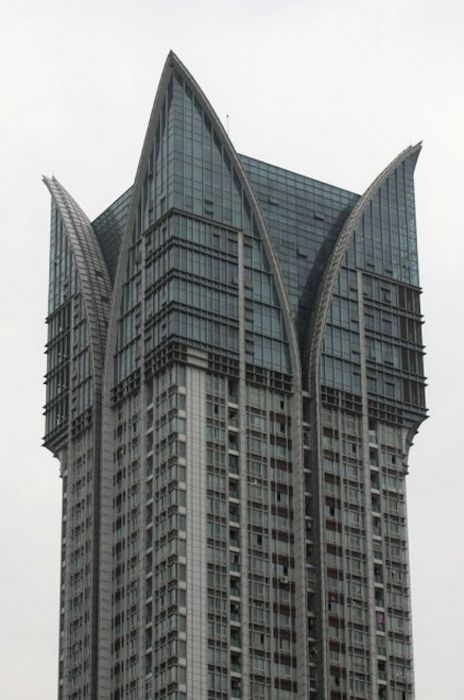
Again in Chongqing. Netizens think that a recent construction project look-alike a zip pullover.
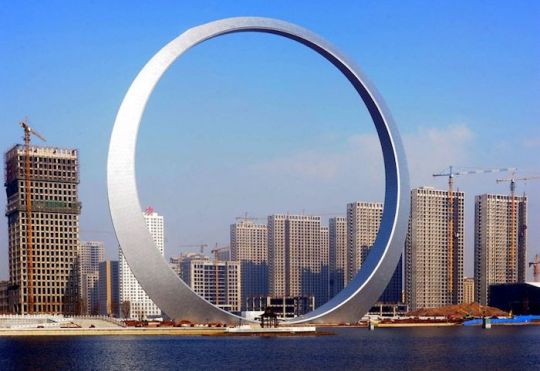
Fushun Shen Fu New Town “Circle of Life” is the new panoramic structure, with a diameter of 157 meters, 50 floors, with installed 12,000 LED lights, 3,000 tons of steel, cost a billion dollars. The project on the web has gained a first place among buildings more ridiculous. The local government has responded that this project will make it a distinctive architectural landscape.
backlink > inhabitat , acidcow , izismile , netasite.net (Japan)
Via EDIFICI STRANI
#ArchitectureInChina, #Beijing, #BeijingOlympicParkWatchtower, #ChinaBuildingPictures, #CrazyBuildingDesigns, #CrazyBuildings, #CuipingWuliangye, #CYLee, #EastGatewayOfSuzhou, #FangyuanMansion, #FushunShenFuNewTown, #Hainan, #Hubei, #Images, #LindaHaiSquare, #PhoenixIslandRealEstate, #SailOfTheCentury, #Sanya, #ShenfuNewTown, #Shenyang, #Suzhou, #Yanjiao, #Yibin, #YichangPeninsula, #Yiling
#architecture in china#beijing#Beijing Olympic Park watchtower#china building pictures#crazy building designs#crazy buildings#Cuiping Wuliangye#CY Lee#East Gateway of Suzhou#Fangyuan Mansion#Fushun Shen Fu New Town#hainan#hubei#images#Linda Hai Square#Phoenix Island Real Estate#Sail of the Century#sanya#shenfu new town#shenyang#suzhou#Yanjiao#yibin#yichang peninsula#Yiling
0 notes
Text
PCM (PRE-COATED METAL) MARKET
The global PCM (Pre-coated Metal) market was valued at xx million in 2019 and is projected to reach US$ xx million by 2026, at a CAGR of xx% during the forecast period. While the PCM (Pre-coated Metal) market size in US was US$ XX million in 2019, and it is expected to reach US$ XX million by the end of 2026, with a CAGR of
Global IoT Gateway Devices Market Research Report 2021 Professional Edition
Global Desulphurization Gypsum Market Research Report 2021 Professional Edition
Global Piperylene Market Research Report 2021 Professional Edition
Global Solar Storage Batteries Market Research Report 2021 Professional Edition
Global Myocardial Infarction Treatment Market Research Report 2021 Professional Edition
US $XX million.
Total Market by Segment:
Italy PCM (Pre-coated Metal) Market, By Type, 2015-2020, 2021-2026 ($ millions) & (Kiloton)
Italy PCM (Pre-coated Metal) Market Segment Percentages, By Type, 2019 (%)
UV-reactive PCM
Inkjet PCM
Others
Italy PCM (Pre-coated Metal) Market Segment Percentages, By Application, 2019 (%)
Washing Machine
Refrigerator
Air Conditioning
Others
Competitor Analysis
Further, the report presents profiles of competitors in the market, including the following:
Shenzhen Welmetal
Shandong Guanzhou
Jiangsu Liba Enterprise
Zhaojian Metal Product
HBIS Steel
Yieh Phui (China) Technomaterial
Zhuhai Speedbird
Suzhou Yangtze New Materials
Hesheng Special Material
YSS (Hefei)
East New Materials (Qingdao) Technology
0 notes
Text
Shanghai – China’s largest city and its principal port, located at the mouth of the Yangtze River delta. Shanghai’s heritage is very mixed given its role as a major trading city, especially as China opened up to international maritime trade in the 18th century onwards. Much of this was forced on the declining Qing Dynasty mostly in the mid-19th century by Western powers via the “Unequal Treaties,” which remain a sensitive point to this day. The expulsion of the various foreign occupiers in the 1949 revolution and subsequent relative isolation of the city through the 1980’s by the victorious Communist regime preserved much of this environment.
Shanghai Business District – East Bank of the Huangpu River
Like many large commercial cities, it’s a fascinating place to visit with plenty to see, and is an excellent base for other China travel. The main issue is that you need to obtain a China entry visa.
Huangpu Neighborhood
Shanghai’s main city area is centered around People’s Square, a large park that also holds some museums, with largely residential districts to the west and the business district to the east. The eastern area is bordered by Shanghai’s famous Bund waterfront on the Huangpu River, with a concentration of unspoiled Art Deco era buildings that is hard to find except in other cities that grew rapidly in the mid-20th century, such as Detroit: https://wp.me/p7Jh3P-nP
The Bund
Shanghai’s layout reflects the two main 19th-20th century foreign settlements – the International Settlement (to the UK and USA) in the east along the riverfront (largely in the eastern part of the Huangpu District); and the French Concession, which runs to the southwest of People’s Square along Huaihai Middle Road and the northern part of the Xuhui District. Just south of the former International Settlement and next to the river is the old city, that was originally a walled city and which remained separate from the International Settlement to the North.
You could easily spend 3-4 days in Shanghai and find plenty to do, especially if you have never visited mainland China before. There are some pedestrian-friendly neighborhoods within the former French Concession area such as the rather upmarket Xintiandi and Tianzifang areas. The old city (start at Yuyuan Garden metro) is south and east of Renmin Road and includes some isolated archaeological remnants and gardens. Here are some ideas of in-town things to do, as well as some area side trips that I’ll write about later.
The Shanghai Museum (People’s Square – south side). If you want an introduction to Chinese history and culture, the Shanghai Museum is equivalent to a national art museum. You can get the various imperial dynasties – going back over 2,000 years – outlined in your head through the extensive watercolor, pottery, currency and other collections. I have always wondered how much of China’s historical artifacts survived the Cultural Revolution in 1966, and notably some of the material came from overseas Chinese collectors. The museum is closed Mondays and has free entry.
There is interesting transitional currency with late 19th/early 20th century bills.
The Bund and Art Deco Shanghai. Manhattan on the Yangtze: Shanghai has a high level of preservation of its buildings from the late 19th through the mid-20th century, and was a major commercial center of East Asia for the first half of the 20th century. You could be downtown in a US city that grew around that time. There are plenty of online offerings for historical tours to understand this – see below, but book ahead. China had been dealing with invasion by Japan since 1931 and Shanghai was attacked by the Japanese in 1932 and then again in 1937, being occupied until 1945.
The main business area is located northeast of People’s Square towards to the Bund, with many of the major buildings lining the Bund. If you want to pick one place to see, the Peace Hotel, originally opened as the Cathay Hotel in 1929, has an impressive Art Deco ground floor area.
Eating Around. Without getting into the usual street food obsession, Shanghai Chinese cooking works very well if you are after something light and casual, and there are plenty of formal restaurants covering the main cooking styles of China. The Shanghainese post-revolution diaspora has meant that many Shanghai specials have worked their way into the Chinese repertoire. A few key types include:
Xiao Long Bao – Soup filled dumplings, usually pork or shrimp, but vegetarian options are common.
Shengjiang Mantou – oh yeah. Soup filled dumplings with a flakier pastry shell, fried around the base.
Hongshao Rou – braised pork belly. A favorite of Chairman Mao apparently, although there are varieties nationwide.
Jiaohua Ji – beggar’s chicken. Stuffed, marinated and roasted in a paper shell.
For the most part, restaurants catering to the local crowd often offer picture menus where the menu is in Chinese. The various city shopping malls usually have a restaurant level – these are usually quite good in Asia as they are clean, bright and air-conditioned, and not at all the usual chain debacle you get in the West. Some that are worth a visit include:
Da Hu Chun (11 Sichuan Street, Huangpu) – full range Shanghai classics.
Di Shui Dong (56 Maoming S Road, Jing’an) – Hunan specialty.
Din Tai Fung ( Jing’an) – actually a Taiwanese chain (whose founder fled China in 1948) featuring Shanghainese specials and known for it’s xiao long bao, but a good entry-level restaurant with a simple menu.
Lao Fan Dian (Fujou and Juixiaocheng Streets, Huangpu) – another Shanghai standard.
Lin Long Fang (10 Jian Guo Dong Lu or SML Center, Huangpu) – great local mini chain.
Nan Ling (1238 Yainan Middle Street, Jing’an) – more formal Shanghai classics.
Shanghai Grandmother (70 Fuzhou Road, Huangpu) – multi-level family style offering.
The French Concession. The French Concession is a more residential, retail and green area, largely north and south of Huaihai Middle Road as it heads southwest from People’s Square, which provides contrast to the more urban/shopping/office focus in the Huangpu/Bund area east of People’s Park. It is also close to the Jing’an temple, which is worth a visit. It has a more relaxed and leafy atmosphere, in part because the French built wider, tree-lined streets. As mentioned earlier, the Xintiandi (aim for the metro station of the same name) and Tianzifang (southwest of the Jianguo West and Sinan Roads intersection) areas are good walking destinations.
Jaywalking on Julu Road
Dance Evening at Xianyang Park
The Jing’an Temple. The Jing’an temple, northwest of the French concession with a metro next to it, is well with a visit, centered around a great hall with a seated Buddha. There has been a temple in the area since 247 CE, and one on the current site since 1216; it burnt down in the 1970’s and was rebuilt in the 1980’s so is quite new, although various artefacts, such as the medieval Hongwu bronze bell, date back a ways. There is a good park just south of the temple to take a break and admire the greenery.
Walking Tours. Shanghai’s sights are well distributed around the neighborhoods and there isn’t a concentration of major points, so a walking tour can be useful. Here are a few and of course Tripadvisor has a selection:
The Shanghai Historical Society focuses on the 19th and 20th century and their walking tours are here: https://www.historic-shanghai.com/events/
Shanghai Walking Tours: http://shanghaiwalkingtour.com/english/walking_tours.html
Culinary Backstreets is food focused: https://culinarybackstreets.com/culinary-walks/shanghai/
Side Trips. There are a few cities in the Yangtze delta that are worth visiting, such as Suzhou and Hangzhou, about 30 and 60 minutes away by rail, respectively. You can always look for a bus or tour service, although rail is good option, connecting into the metro at both cities. Suzhou is a compact medieval city better suited to a day trip, while Hangzhou and it’s famous lake and forested hill park are more for an overnight stay.
Suzhou
Closer in is the canal town of Zhujiajiao, located in the western outskirts of the city facing Lake Dianshan, at the metro stop of the same name.
Logistics. I stayed at the Mansion Hotel (Xinle and Xiangyang Roads, Jing’an) and the Jing’an Campanile (425 Wulumuqi North Road), in the French Concession and Jing’an areas, respectively. Both have proximity to the metro which is worthwhile here. The Mansion Hotel is a one of a set of smaller hotels restoring pre-war Shanghai mansions, here designed by French architects in 1932 for a Shanghai syndicate leader and opened in 2007.
Airports. Shanghai is served by two airports – Pudong (PVG), the newer principal international gateway located east of the city on the coast; and Hongqiao (SHA), the original secondary airport located west of the city. Both have Metro stations and are about 60 and 45 minutes from People’s Square respectively. Pudong is also served by a fast (300 km/h) Maglev line to the Longyang Road Station in the eastern suburbs. This may save you some time although as you will have to change to get to the center it may be simpler to just use the metro.
Metro. The Shanghai Metro is an excellent way to get around the city. You can purchase a range of passes at the airport station or at any of the station customer service centers. Apart from individual tickets, there are 1- and 3-day passes or alternatively you can just buy the Shanghai Public Transportation Card which starts at Y100 and includes a Y20 deposit refundable on return of the card. Note that the metro stations are quite large and also have a security check (including bag x-ray machine). As to cab and ride hailing alternatives, note that Uber does not operate in China – you can try the main Chinese provider, Didi Chuxing, but check online for the latest as far as obtaining an English version of the app. Logistically, note that all metro entrances have a security checkpoint (with baggage x-ray so don’t carry a bag unless necessary) before the ticket barriers.
The Shanghai Metro is Extensive
Rail. China’s high-speed rail system is comfortable, fast, cost-effective and well worth trying. The two main issues you should factor in include the high passenger volume it manages in a country of 1.4 billion people, and the airport-style security requirements at rail stations. This means you need to plan your journey and factor in time beforehand. Many trains are 100% occupied so unless you don’t mind a “standing” ticket, you should book in advance: trip.com is a useful website. Secondly, you will need your passport to buy or pick up your ticket, after which you will go through a security check (including baggage x-ray) where you will present your ticket and passport. The ticket is scanned again when you enter the platform via the boarding gate. If you book for a certain departure time, there will be a specific departure gate that usually open about 15 minutes pre-departure. If you allow 15 minutes to buy or pick up your ticket from the ticket office queue (there are self service machines with only Chinese language access), 15 minutes to enter the station, pass security and navigate to your gate, and then assume you get in line at the gate 15 minutes pre-departure, for your first time I would allow arriving at the station at least 45 minutes pre-departure. At post-journey arrival, at the larger stations you are sent through a separated (from the departures) arrivals level and put out into a pre-security area.
Hongqiao Railway Station Main Departures Hall
Shanghai has four rail stations, the more central Shanghai Rail Station, Hongqiao (out west near the airport), the South and West stations. Note that the ticket office at the central station is in a separate building across from the main entrance. At Hongqiao, the ticket office is post-security in the main departures hall. The ticket offices are typically busy however the lines move quite fast.
Rapidly Moving Ticket Line, Shanghai Train Station
Your Chinese Language Skills. Lack of Mandarin Chinese language skills is not much of an issue; all public signs are bilingual Chinese/English – even the metro ticket vending machines have an “English” button on their touchscreen displays. Since China’s schools have had English language training from about 8 years of age for some time now, English is more commonly spoken to some extent. However, you should still either pick up a basic language guide or go to the many Mandarin Chinese language Youtube offerings in advance of the trip.
Stuck for a Gift? The First Food Hall (720 Nanjing Road East) is worth going to for a one-stop that covers Chinese products. A four-storey supermarket and food court, it has the feel of something from the Communist era and so is worth going to. Nanjing Road East is the main shopping street, pedestrianized east of People’s Square.
Craft Beer. Craft beer has reached China, or at least it’s more expat and overseas travelled populations, and it’s worth trying. Not surprisingly, the main providers are mostly in the French Concession area and you should focus on:
Boxing Cat Brewery (82 Fu Xing Road West and (under refit in July 2019) 521 Fu Xing Middle Road. My favorite I have to say, with the very floral and moderately bitter Sucker Punch pale ale, the very solid TKO west coast IPA and the excellent King Louie imperial stout.
Liquid Laundry (Kwah Centre 2/F, 1028 Huaihai Middle Road). Gastropub owned by Boxing Cat and with a solid beer menu including other beers and their own line. Good pale ales and IPAs.
Shanghai Brewing Company (15 Dongping Road). Decent craft beer selection.
Stone Brewing Tap Room (1107 Yu Yuan Road). Not entirely local as the San Diego area brewery expands globally, but worth supporting.
Shanghai’d Shanghai – China’s largest city and its principal port, located at the mouth of the Yangtze River delta.
0 notes
Text
BEST DESTINATIONS IN CHINA
1) Beijing
Beijing, the capital of China, has served as a capital of the country for more than 800 years. The city has many places of historic interest and scenic beauty, including the Forbidden City - the largest and best-preserved ancient architectural complex in the world; the Temple of Heaven - where Ming and Qing emperors performed solemn rituals for bountiful harvests; the Summer Palace - the emperors' magnificent garden retreat; the Ming Tombs - the stately and majestic mausoleums of 13 Ming Dynasty emperors; and the world-renowned and genuinely inspiring Badaling section of the Great Wall.
2) Shanghai
Shanghai is one of the world largest seaports and China major industrial as well as commercial center. With the deepening reform, the city, formerly crowned as the financial, economic and trade hub of the Far East, is playing a leading role in boosting economic development of China. Meanwhile, the city has attracted more and more tourists from home and abroad for its unique charm. As one of the noted historic and cultural citied in the country, Shanghai has more than 70 sites of historical interest and cultural relics, which best represent the distinctive characteristic of Shanghai regional culture. What is more, Shanghai is the Paradise of gourmets, who may find thousands of restaurants here that serve a complete list of China's major famous cuisines and various foreign foods.
3) Xi'an - Home of the Terracotta Warriors
Xian, an ancient capital of China, is your gateway to know about ancient Chinese civilization. In its 3,100 recorded years of evolution, it has been the capital of 13 dynasties, including the Zhou, Qin, Han, the Sui, and Tang dynasties, periodically from the 11th century B.C. to the early 10th century AD. Touring in Xi'an, you can breathe the historical air from all the must-see spots. major attractions in Xi'an include the Qin Terracotta Army - "the 8th wonder of the world", the Big Wild Goose Pagoda - the most outstanding landmark of Xi'an, Banpo Neolithic Village Museum - the remains of a 6,000 year-old village once home to a matriarchal clan community, and the Xi'an City Wall which stretches round the old city.
4) Hong Kong - Shopping paradise
Hong Kong is located on south coast of China, 60 km (37 mi) east of Macau on the opposite side of the Pearl River Delta, north to Shengzhen. It boards Guangdong city of Shenzhen to the north over the Shenzhen River, Wanshan Islands of Zhuhai in Guangdong Province to the south. It consists of Hong Kong Island, Kowloon Peninsula, the New Territories and other 262 small islands.
Hong Kong is a highly prosperous international metropolis now, and one of the third largest financial centers in the world. Hong Kong is famous for magnificient city view with lots of skyscrapers and shopping.
5) Guilin - Scenic city with sensational mountain and river scenery
Situated in South China, Guilin is like a glittering pearl on a green carpet, the scenery here enjoys the praise of "top landscape in the world". The name of the city is derived from the cassia tree called "Guihuashu" in Chinese. One can see the green cassia trees standing at the most roadsides in the town. When the autumn comes, the fragrance of the blossom fills up the air making passengers refreshing and relaxed. In addition, the golden flowers are very pleasing to the eyes.
Guilin is a world-famous scenic city, famous for its unrivalled karst landscape, exquisite mountains, limpid rivers, wired caves and beautiful rocks. Besides the unparallel scenery, the city also boasts its time-honored history. Guilin has been the political, economic and cultural center of Guangxi since more than 1,000 years ago. The Lingqu Canal built 214 B.C. in Xing'an County has witnessed the change during these 2,000 years.
6) Guangzhou - A prosperous and liberal city near Hong Kong
Guangzhou, the capital city of Guangdong Province, is nicknamed the City of Goat. As a city of historic and cultural significance, it is the largest industrial and commercial city and the largest important and export port in South China. It enjoys a humid climate all year around, and flowers blossom in all four seasons, hence its another nickname "the City of Flowers". There are over 150 historical sites and places of interests in the city, plus various modern entertainment facilities. Here, the China Guangdong Export Commodities Fairs is held twice every year.
7) Chengdu - Hometown of China Giant Panda
Chengdu, the capital of Sichuan Province, is a famous historical and cultural city with a history over 3,000 years. Known as the land of abundance, Chengdu boasts plentiful local products, a pleasant climate, a large number of scenic spots and historical sites, and fine traditional handicrafts well known both at home and abroad.According to the records and relics, there was human being living on this piece of land about 3,700 years ago. It is about 2,300 years ago the ninth king Kaiming of ancient Shu State moved his capital to the site and named it 'Chengdu'. Then the name has been kept until today.
8) Hangzhou - Beautiful city with lake view
As one of China's hottest tourists destination, Hangzhou is a “holy and beautiful paradise on earth” which has been circulated for l, 000 years on the Chinese land. It has inherited the historical heritage of mare than 5,000 years. The city has a history of 2.200 years since it was first established as Qiantang County during the Qin Dynasty. Altogether 13 emperors of two dynasties took the throne for 234 years in Hangzhou. Later, Hangzhou has always been the administrative, cultural and economic city (capital city) of Zhejiang Province and is one of the seven ancient capitals in China. Located on the south bank of the Haogzhou Bay of the East China Sea. Hangzhou is 180 km from Shanghai and is an important central city of the Yangtze River delta. Hangzhou has enjoyed the reputation of being the "first prefecture in southeast'. During the Yuan Dynasty Italian traveller Marco Polo lauded. The special local-made products are silk, Xihu silk umbrellas, color-glazed porcelain, Longjing tea, and white chrysanthemum.
9) West Lake in Hangzhou
Suzhou - An ancient city famous for canals and gardens
Founded in 514 BC, Suzhou is one of the oldest towns in Yangtze Basin. Bordering Shanghai on the east, Wuxi City on the west and the Yangtze River on the north, Suzhou enjoys great geography and excellent land, water and air transportation.Suzhou achieved its fame 1,000 years later when the Grand Canal was constructed. And the city remains one of the most beautiful cities in China with its blue web of interlocking canals and classical gardens as well as famous silk industry. It is well-known as the capital of silk. The streets and lanes in its downtown area are of the Song-dynasty style.
As the world of garden, Suzhou is also famous for its ancient gardens which are the gem of classical garden architecture in south China and has been included in the UNESCO heritage list.
10) Sanya - A tropical city with beautiful sand beach
Sanya is a famous coastal tourist city filled with tropical landscapes and local customs. Since Sanya is situated in the southernmost part of China, she has been called "the remotest cape of the earth" since ancient time.The region of Sanya has a long history of human development. There were discoveries of cultural relics of the Old Stone Age. Ancient Persian tombs were found along the coast. As the world famous tourism city, Sanya, has advantages on its air transportation, especially for the international ones. Phoenix Airport is 20 km northwest away from the city. Now, there are 9 international airlines from Singapore, HongKong, Malasia, Thailand, Seoul, Tokyo and Osaka.There is a highway linking the airport and the city center. You can take a taxi or a bus to the city centre. In addition there are direct buses to Sanya Bay and Dadonghai at the airport.
Check out this app for more information: https://www.flickstree.com/video-category.html/TRAVEL_VIDEOS
0 notes
Video
youtube
[https://youtu.be/tGpeGqaa-zA] Welcome to Gulf Hotel Bahrain Convention & Spa in Manama, Bahrain (Middle East). The general services in the establishment will be wifi available in all areas. squash, darts, billiards and cycling. In the section of bars we will be able to enjoy restaurant (buffet), breakfast in the room, restaurant, snack bar, fruits, on-site coffee house, packed lunches, kid meals, bottle of water, room service, bar, kid-friendly buffet and restaurant (à la carte). For health, the establishment offers make up services, waxing services, facial treatments, hair treatments, massage, fitness centre, steam room, manicure, swimming pool, sauna, head massage, fitness/spa locker rooms, hand massage, spa facilities, body scrub, yoga classes, neck massage, body treatments, hot tub/jacuzzi, foot massage, hammam, back massage, beauty services, hair styling, foot bath, hair cut, massage chair, body wrap, spa lounge/relaxation area, spa/wellness packages, hair colouring, fitness, pedicure, couples massage, spa and wellness centre, full body massage, personal trainer, fitness classes, light therapy, outdoor pool (all year) and pool/beach towels. As far as transport is concerned, we have airport shuttle (additional charge), airport shuttle, secured parking, airport drop off, car hire, shuttle service, airport pick up, accessible parking and shuttle service (additional charge). For reception services we can find safety deposit box, private check-in/check-out, express check-in/check-out, concierge service, luggage storage, newspapers, ticket service, tour desk, currency exchange and 24-hour front desk. For the leisure of the family we can dispose of children's playground and babysitting/child services. The function of the cleaning services have included dry cleaning, ironing service, trouser press and laundry. If you travel for business affairs in the establishment you will find meeting/banquet facilities and fax/photocopying. gift shop, shops (on site) and barber/beauty shop. We will be able to highlight other possibilities as facilities for disabled guests, bridal suite, family rooms, vip room facilities, lift, heating and air conditioning Book now cheaper in http://ift.tt/2x2XHAU You can find more info in http://ift.tt/2xRbXAA We hope you have a pleasant stay in Gulf Hotel Bahrain Convention & Spa Other hotels in Manama Sofitel Bahrain Zallaq Thalassa Sea & Spa https://youtu.be/CJIqCFbu0Yo Mövenpick Hotel Bahrain https://youtu.be/xEOXvpDKKgg Crowne Plaza Bahrain https://youtu.be/kijcyX4hU00 Sheraton Bahrain Hotel https://youtu.be/ldibEIdnU28 Other hotels in this channel ibis London Shepherds Bush - Hammersmith https://youtu.be/8hI2DSYERyk Eastern & Oriental Hotel https://youtu.be/V9ZXb11bMZ0 Pestana Chelsea Bridge Hotel & Spa https://youtu.be/Ufr07H9b_8Q Hotel Madera Hollywood https://youtu.be/B9wx2W8n9xc 10 2nd Avenue Houghton Estate https://youtu.be/DO_XBM5tohI Katikies Hotel https://youtu.be/YjhDJxf3nvc Avonmore Hotel https://youtu.be/EpF1CJqzK5w Fellah Hotel https://youtu.be/A30tTtpu5Gc The Gateway Hotel IT Expressway https://youtu.be/MsmRzlPM2hw Luthan Hotel And Spa - A Women Only Hotel https://youtu.be/WMbq-sI1Bac Suzhou Joy Holiday Hotel https://youtu.be/faq-EAKhQHw Vitalhotel Alter Meierhof https://youtu.be/i7qnVYnvEvo Ramada Olympia https://youtu.be/DPDxNcfyT2k Central Ridge Boutique Hotel https://youtu.be/bdEJK9SgeFc Casa Cartagena Boutique Hotel & Spa https://youtu.be/dsXW0X6H52s We hope you have a pleasant stay in Gulf Hotel Bahrain Convention & Spa All images used in this video are or have been provided by Booking. If you are the owner and do not want this video to appear, simply contact us. by World Hotel Video
0 notes
Text
Tourism Imbalance Is Vexing Problem in U.S.-China Travel
A scene in Suzhou, China on October 3, 2016. Few tourists venture out of China's big cities. Visit Suzhou
Skift Take: One market where the U.S. leads China in a trade imbalance: The United States is taking in way more tourists from China than it’s sending. Pollution, bureaucracy, and bang for buck are the major factors.
— Steven Schwankert
Editor’s Note: Skift launched a series, Gateway, as we broaden our news coverage geographically with first-hand, original stories from correspondents embedded in cities around the world.
We started with regular reports several times per month from tourism hubs Beijing, Singapore and Capetown. Gateway Beijing and Gateway Singapore, for example, signify that the reporters are writing from those cities although their coverage of the business of travel will meander to other locales in their regions. Read about the series here, and check out all the stories in the series here.
The nine-figure outbound travel stats for China are sizzling, along with the multi-billion dollar numbers associated with Chinese travelers spending worldwide. Click through any number of Skift stories and read how domestic and international air routes are expanding, hotels are being constructed and opening. China is still one of the best travel industry stories going.
Except when the subject turns to inbound tourism to China.
Despite featuring a number of bucket list sites like the Great Wall and the Terracotta Army, visitors from outside of Asia aren’t finding China to be their cup of tea.
Nine years ago, a visit to China was on just about every travel list, spearheaded by Beijing’s hosting of the 2008 summer Olympics. But instead of being a transformative, coming-out party for the Chinese capital the way the Games had been for Barcelona and Sydney, almost from the moment the torch went out, the city and the country’s non-Asian tourism fortunes began to decline.
According to the China National Tourism Administration, from January to September 2015, 3.57 million Europeans and 2.3 million North Americans visited China, out of just less than 19 million foreign arrivals. That number is part of a measly one percent growth rate that China tourism has managed over the past decade, at least for the years where clear statistics are available, 2005-2015, Beijing-based Center for China & Globalization wrote in a recent report [http://bit.ly/2ezGeZQ].
A Lack of Appeal
Like every other aspect of China’s relationship with the rest of the world, the reasons for the country’s lack of appeal to many foreign tourists are complex.
“So much of the tourism infrastructure in someplace like Beijing (and, increasingly, around the world, although that’s another story…) is geared toward the domestic Chinese tourist,” said Jeremiah Jenne, founder and proprietor of Beijing by Foot, an educational walks company.
“This is a big difference from other Asian cities like Bangkok or Kuala Lumpur, where ‘tourist’ still often means from North America, Europe, or Australia, and so the marketing, the infrastructure, the whole vibe is geared toward that particular culture of travel and expectations. But it’s more than just English-language menus and service without a scowl, it also comes down to how the city is being developed.”
Part of the problem is what’s on offer. China is a hardcore cultural trek with a significant language barrier. Whether as part of a group, for the business traveler, or the independent visitor, China is a tough destination from the moment of arrival. Taxi drivers don’t speak English, and rip-offs are routine. That’s the case even though hotel infrastructure at almost every level is now international standard,
Then there’s the pollution. While China is home to a few of the world’s most polluted cities according to the World Health Organization, Beijing and Shanghai aren’t among them. Thanks to copious news coverage of every “airpocalypse” that descends upon Beijing especially that city has become as synonymous with choking pollution much as Dickensian London was associated with juvenile crime and cruelty. Not a big boost for tourism when the city is referred to as “the big smoke.”
Visa Program has Fallen Short
Measures designed to make travel to parts of China beyond Beijing or Shanghai have been largely unsuccessful. Since 2013, Beijing has offered visa-free, 72-hour stays to passport holders from about 50 nations. However, despite having a target of 20,000 travelers per year, the program has fallen short, attracting only 14,000 its first year.
Considering that Beijing is a jumping-off point for growing destinations like Mongolia and parts of Central Asia, that scheme’s failure seems to indicate that travelers are not just going elsewhere, but actively avoiding China, or at least Beijing. Earlier this year, the program expanded to 144 hours (six days), and allows travelers to venture outside of Beijing to neighboring Tianjin and the surrounding province of Hebei. Similar programs exist for Shanghai as an entry point with travel to Jiangsu and Zhejiang provinces, and for southern China’s Guangdong province.
Nor have other tourism initiatives, including Times Square advertising featuring China’s two international icons – former NBA star Yao Ming and pandas – or buying a half-hour of programming on New York’s ABC affiliate in 2015.
Part of the problem is bureaucratic. Single entry, double entry, and multiple-entry visas for U.S. passport holders all cost $140 and require four business days to process. Visa applications must be made in person or by an authorized agent. Travelers are required to show both air ticket and hotel reservations at the time of application.
In fairness, part of the reason for the hassle is that People’s Republic of China passport holders face similar fees and application hurdles when visiting the United States. But the average traveler planning a bucket list trip or honeymoon is probably not considering that aspect of Sino-American relations when it’s time to buy plane tickets.
Considering that American citizens can visit almost every other country in East and Southeast Asia visa-free – Bhutan and North Korea are the exceptions – and that Southeast Asian destinations in particular offer good value in U.S. dollar terms, in addition to sights and beaches, then for the money and the prospect of 12-plus hours on a plane, China quickly slides down the list. China’s strengthening currency has helped the country in a number of ways, but not when it comes to attracting tourists.
The remaining issues are psychological. China remains a very safe destination for travelers (except for the usual tourist rip-offs), and foreign guests on the whole are treated well. However, the demonization of China during the 2016 U.S. presidential election cast the country in a bad light as a stealer of American jobs and technology.
China had its first big tourism moment in the 1980s, up until the 1989 Tiananmen Square massacre. It returned to form in the latter half of the 1990s, then gained momentum in the run-up to the 2008 Olympics. With infrastructure improving, the current lag may simply be a quiet period before it takes another run at the world stage when it hosts the 2022 Winter Olympics.
0 notes
Text
Tourism Imbalance Is Vexing Problem in U.S.-China Travel
A scene in Suzhou, China on October 3, 2016. Few tourists venture out of China's big cities. Visit Suzhou
Skift Take: One market where the U.S. leads China in a trade imbalance: The United States is taking in way more tourists from China than it’s sending. Pollution, bureaucracy, and bang for buck are the major factors.
— Steven Schwankert
Editor’s Note: Skift launched a series, Gateway, as we broaden our news coverage geographically with first-hand, original stories from correspondents embedded in cities around the world.
We started with regular reports several times per month from tourism hubs Beijing, Singapore and Capetown. Gateway Beijing and Gateway Singapore, for example, signify that the reporters are writing from those cities although their coverage of the business of travel will meander to other locales in their regions. Read about the series here, and check out all the stories in the series here.
The nine-figure outbound travel stats for China are sizzling, along with the multi-billion dollar numbers associated with Chinese travelers spending worldwide. Click through any number of Skift stories and read how domestic and international air routes are expanding, hotels are being constructed and opening. China is still one of the best travel industry stories going.
Except when the subject turns to inbound tourism to China.
Despite featuring a number of bucket list sites like the Great Wall and the Terracotta Army, visitors from outside of Asia aren’t finding China to be their cup of tea.
Nine years ago, a visit to China was on just about every travel list, spearheaded by Beijing’s hosting of the 2008 summer Olympics. But instead of being a transformative, coming-out party for the Chinese capital the way the Games had been for Barcelona and Sydney, almost from the moment the torch went out, the city and the country’s non-Asian tourism fortunes began to decline.
According to the China National Tourism Administration, from January to September 2015, 3.57 million Europeans and 2.3 million North Americans visited China, out of just less than 19 million foreign arrivals. That number is part of a measly one percent growth rate that China tourism has managed over the past decade, at least for the years where clear statistics are available, 2005-2015, Beijing-based Center for China & Globalization wrote in a recent report [http://ift.tt/2vFQnzl].
A Lack of Appeal
Like every other aspect of China’s relationship with the rest of the world, the reasons for the country’s lack of appeal to many foreign tourists are complex.
Part of the problem is what’s on offer. China is a hardcore cultural trek with a significant language barrier. Whether as part of a group, for the business traveler, or the independent visitor, China is a tough destination from the moment of arrival. Taxi drivers don’t speak English, and rip-offs are routine. That’s the case even though hotel infrastructure at almost every level is now international standard,
Then there’s the pollution. While China is home to a few of the world’s most polluted cities according to the World Health Organization, Beijing and Shanghai aren’t among them. Thanks to copious news coverage of every “airpocalypse” that descends upon Beijing especially that city has become as synonymous with choking pollution much as Dickensian London was associated with juvenile crime and cruelty. Not a big boost for tourism when the city is referred to as “the big smoke.”
Visa Program has Fallen Short
Measures designed to make travel to parts of China beyond Beijing or Shanghai have been largely unsuccessful. Since 2013, Beijing has offered visa-free, 72-hour stays to passport holders from about 50 nations. However, despite having a target of 20,000 travelers per year, the program has fallen short, attracting only 14,000 its first year.
Considering that Beijing is a jumping-off point for growing destinations like Mongolia and parts of Central Asia, that scheme’s failure seems to indicate that travelers are not just going elsewhere, but actively avoiding China, or at least Beijing. Earlier this year, the program expanded to 144 hours (six days), and allows travelers to venture outside of Beijing to neighboring Tianjin and the surrounding province of Hebei. Similar programs exist for Shanghai as an entry point with travel to Jiangsu and Zhejiang provinces, and for southern China’s Guangdong province.
Nor have other tourism initiatives, including Times Square advertising featuring China’s two international icons – former NBA star Yao Ming and pandas – or buying a half-hour of programming on New York’s ABC affiliate in 2015.
Part of the problem is bureaucratic. Single entry, double entry, and multiple-entry visas for U.S. passport holders all cost $140 and require four business days to process. Visa applications must be made in person or by an authorized agent. Travelers are required to show both air ticket and hotel reservations at the time of application.
In fairness, part of the reason for the hassle is that People’s Republic of China passport holders face similar fees and application hurdles when visiting the United States. But the average traveler planning a bucket list trip or honeymoon is probably not considering that aspect of Sino-American relations when it’s time to buy plane tickets.
Considering that American citizens can visit almost every other country in East and Southeast Asia visa-free – Bhutan and North Korea are the exceptions – and that Southeast Asian destinations in particular offer good value in U.S. dollar terms, in addition to sights and beaches, then for the money and the prospect of 12-plus hours on a plane, China quickly slides down the list. China’s strengthening currency has helped the country in a number of ways, but not when it comes to attracting tourists.
The remaining issues are psychological. China remains a very safe destination for travelers (except for the usual tourist rip-offs), and foreign guests on the whole are treated well. However, the demonization of China during the 2016 U.S. presidential election cast the country in a bad light as a stealer of American jobs and technology.
China had its first big tourism moment in the 1980s, up until the 1989 Tiananmen Square massacre. It returned to form in the latter half of the 1990s, then gained momentum in the run-up to the 2008 Olympics. With infrastructure improving, the current lag may simply be a quiet period before it takes another run at the world stage when it hosts the 2022 Winter Olympics.
0 notes
Text
9 Of The Most Striking Skyscrapers With Holes In Them
For Architectural Digest, by Nick Mafi.
For much of modern history, skyscrapers were merely very tall structures with wholly uniform façades. Yet over time architects began to manipulate the exteriors, sometimes removing entire sections altogether. Not only do buildings with holes in them offer city dwellers bold new forms to admire from the outside, but tenants within can enjoy sources of light that more traditional skyscrapers preclude. From an OMA-designed science center in Hamburg to a tower by Zaha Hadid in Dubai, AD looks at the most daring examples of buildings that celebrate the void.
CCTV Tower (Beijing)
Designed in 2008 by Rem Koolhaas and Ole Scheeren, the CCTV Tower in Beijing has become an icon in the city’s bustling business district.
Grande Arche de la Défense (Paris)
Opened on July 14, 1989, the bicentennial of the French Revolution, the Grande Arche de la Défense in Paris was built as a 20th-century version of the Arc de Triomphe — a structure that’s symbolic of the country’s military strength. Standing 360 feet tall, the building was designed by the Danish architect Johan Otto von Spreckelsen, after he won an international competition.
World Financial Center (Shanghai)
Described by the the Council on Tall Buildings and Urban Habitat as “nothing short of genius,” the World Financial Center in Shanghai rises 1,614 feet. The building, designed by New York–based firm KPF, includes office and retail space, as well as a Park Hyatt hotel.
Marina 106 (Dubai)
Designed by UAE-based National Engineering Bureau and set to be completed in 2019, Dubai’s Marina 106 will be a luxury residential skyscraper that stretches 1,460 feet into the sky. The tower features a long vertical line on two of its sides, guiding the eye up toward larges holes at the top of the structure.
Guangzhou Circle (Guangzhou, China)
Standing some 452 feet tall, the Guangzhou Circle is one of the bolder buildings in the world. The doughnut-shaped structure was designed by the Italian architect Joseph di Pasquale and sits on the banks of the Zhujiang River in southeastern China.
The Gate of the East (Suzhou, China)
The 990-foot-high Gate of the East is the tallest structure in the eastern Chinese city of Suzhou. Designed by London-based firm RMJM and completed in 2014, the building was meant to symbolize a gateway to the city, welcoming people to a new and modern China.
The Mirador (Madrid)
Designed by Dutch firm MVRDV, the Mirador in Madrid is a collection of several types of units stacked together into a modular form. The residential structure includes a garden for its occupants and boasts splendid views of the nearby Guadarrama Mountains.
Hamburg Science Center (Hamburg)
Designed by venerable architecture firm OMA, the as-yet-unrealized Hamburg Science Center would be constructed of ten modular blocks.
Opus Office Tower (Dubai)
Designed by the late Zaha Hadid, the Opus Office Tower in Dubai will house apartment units and a hotel when the structure is completed later this decade. The holistic building includes the signature curves that made the Iraqi-born architect one of the most recognized in the world.
More from Architectural Digest:
See What's Inside Donald Trump's Former Superyacht
14 of the Most Luxurious Yacht Decks
10 Incredible Ski Resorts
The 10 Best New Luxury Cruises
The World’s Best Oceanfront Hotels
10 Hotels with Unbelievably High-End Amenities
— This feed and its contents are the property of The Huffington Post, and use is subject to our terms. It may be used for personal consumption, but may not be distributed on a website.
from Travel – The Huffington Post ift.tt/2k6ha0y
The post 9 Of The Most Striking Skyscrapers With Holes In Them appeared first on YachtAweigh.
source http://yachtaweigh.com/9-of-the-most-striking-skyscrapers-with-holes-in-them/
from http://yatchaweigh.blogspot.com/2017/01/9-of-most-striking-skyscrapers-with.html
0 notes
Text
9 Of The Most Striking Skyscrapers With Holes In Them
For Architectural Digest, by Nick Mafi.
For much of modern history, skyscrapers were merely very tall structures with wholly uniform façades. Yet over time architects began to manipulate the exteriors, sometimes removing entire sections altogether. Not only do buildings with holes in them offer city dwellers bold new forms to admire from the outside, but tenants within can enjoy sources of light that more traditional skyscrapers preclude. From an OMA-designed science center in Hamburg to a tower by Zaha Hadid in Dubai, AD looks at the most daring examples of buildings that celebrate the void.
CCTV Tower (Beijing)
Designed in 2008 by Rem Koolhaas and Ole Scheeren, the CCTV Tower in Beijing has become an icon in the city’s bustling business district.
Grande Arche de la Défense (Paris)
Opened on July 14, 1989, the bicentennial of the French Revolution, the Grande Arche de la Défense in Paris was built as a 20th-century version of the Arc de Triomphe — a structure that’s symbolic of the country’s military strength. Standing 360 feet tall, the building was designed by the Danish architect Johan Otto von Spreckelsen, after he won an international competition.
World Financial Center (Shanghai)
Described by the the Council on Tall Buildings and Urban Habitat as “nothing short of genius,” the World Financial Center in Shanghai rises 1,614 feet. The building, designed by New York–based firm KPF, includes office and retail space, as well as a Park Hyatt hotel.
Marina 106 (Dubai)
Designed by UAE-based National Engineering Bureau and set to be completed in 2019, Dubai’s Marina 106 will be a luxury residential skyscraper that stretches 1,460 feet into the sky. The tower features a long vertical line on two of its sides, guiding the eye up toward larges holes at the top of the structure.
Guangzhou Circle (Guangzhou, China)
Standing some 452 feet tall, the Guangzhou Circle is one of the bolder buildings in the world. The doughnut-shaped structure was designed by the Italian architect Joseph di Pasquale and sits on the banks of the Zhujiang River in southeastern China.
The Gate of the East (Suzhou, China)
The 990-foot-high Gate of the East is the tallest structure in the eastern Chinese city of Suzhou. Designed by London-based firm RMJM and completed in 2014, the building was meant to symbolize a gateway to the city, welcoming people to a new and modern China.
The Mirador (Madrid)
Designed by Dutch firm MVRDV, the Mirador in Madrid is a collection of several types of units stacked together into a modular form. The residential structure includes a garden for its occupants and boasts splendid views of the nearby Guadarrama Mountains.
Hamburg Science Center (Hamburg)
Designed by venerable architecture firm OMA, the as-yet-unrealized Hamburg Science Center would be constructed of ten modular blocks.
Opus Office Tower (Dubai)
Designed by the late Zaha Hadid, the Opus Office Tower in Dubai will house apartment units and a hotel when the structure is completed later this decade. The holistic building includes the signature curves that made the Iraqi-born architect one of the most recognized in the world.
More from Architectural Digest:
See What’s Inside Donald Trump’s Former Superyacht
14 of the Most Luxurious Yacht Decks
10 Incredible Ski Resorts
The 10 Best New Luxury Cruises
The World’s Best Oceanfront Hotels
10 Hotels with Unbelievably High-End Amenities
— This feed and its contents are the property of The Huffington Post, and use is subject to our terms. It may be used for personal consumption, but may not be distributed on a website.
from Travel – The Huffington Post ift.tt/2k6ha0y
The post 9 Of The Most Striking Skyscrapers With Holes In Them appeared first on YachtAweigh.
from http://yachtaweigh.com/9-of-the-most-striking-skyscrapers-with-holes-in-them/
from https://yachtaweigh.tumblr.com/post/156411867451
0 notes
Text
9 Of The Most Striking Skyscrapers With Holes In Them
For Architectural Digest, by Nick Mafi.
For much of modern history, skyscrapers were merely very tall structures with wholly uniform façades. Yet over time architects began to manipulate the exteriors, sometimes removing entire sections altogether. Not only do buildings with holes in them offer city dwellers bold new forms to admire from the outside, but tenants within can enjoy sources of light that more traditional skyscrapers preclude. From an OMA-designed science center in Hamburg to a tower by Zaha Hadid in Dubai, AD looks at the most daring examples of buildings that celebrate the void.
CCTV Tower (Beijing)
Designed in 2008 by Rem Koolhaas and Ole Scheeren, the CCTV Tower in Beijing has become an icon in the city’s bustling business district.
Grande Arche de la Défense (Paris)
Opened on July 14, 1989, the bicentennial of the French Revolution, the Grande Arche de la Défense in Paris was built as a 20th-century version of the Arc de Triomphe — a structure that’s symbolic of the country’s military strength. Standing 360 feet tall, the building was designed by the Danish architect Johan Otto von Spreckelsen, after he won an international competition.
World Financial Center (Shanghai)
Described by the the Council on Tall Buildings and Urban Habitat as “nothing short of genius,” the World Financial Center in Shanghai rises 1,614 feet. The building, designed by New York–based firm KPF, includes office and retail space, as well as a Park Hyatt hotel.
Marina 106 (Dubai)
Designed by UAE-based National Engineering Bureau and set to be completed in 2019, Dubai’s Marina 106 will be a luxury residential skyscraper that stretches 1,460 feet into the sky. The tower features a long vertical line on two of its sides, guiding the eye up toward larges holes at the top of the structure.
Guangzhou Circle (Guangzhou, China)
Standing some 452 feet tall, the Guangzhou Circle is one of the bolder buildings in the world. The doughnut-shaped structure was designed by the Italian architect Joseph di Pasquale and sits on the banks of the Zhujiang River in southeastern China.
The Gate of the East (Suzhou, China)
The 990-foot-high Gate of the East is the tallest structure in the eastern Chinese city of Suzhou. Designed by London-based firm RMJM and completed in 2014, the building was meant to symbolize a gateway to the city, welcoming people to a new and modern China.
The Mirador (Madrid)
Designed by Dutch firm MVRDV, the Mirador in Madrid is a collection of several types of units stacked together into a modular form. The residential structure includes a garden for its occupants and boasts splendid views of the nearby Guadarrama Mountains.
Hamburg Science Center (Hamburg)
Designed by venerable architecture firm OMA, the as-yet-unrealized Hamburg Science Center would be constructed of ten modular blocks.
Opus Office Tower (Dubai)
Designed by the late Zaha Hadid, the Opus Office Tower in Dubai will house apartment units and a hotel when the structure is completed later this decade. The holistic building includes the signature curves that made the Iraqi-born architect one of the most recognized in the world.
More from Architectural Digest:
See What's Inside Donald Trump's Former Superyacht
14 of the Most Luxurious Yacht Decks
10 Incredible Ski Resorts
The 10 Best New Luxury Cruises
The World’s Best Oceanfront Hotels
10 Hotels with Unbelievably High-End Amenities
— This feed and its contents are the property of The Huffington Post, and use is subject to our terms. It may be used for personal consumption, but may not be distributed on a website.
from Travel – The Huffington Post ift.tt/2k6ha0y
The post 9 Of The Most Striking Skyscrapers With Holes In Them appeared first on YachtAweigh.
from http://yachtaweigh.com/9-of-the-most-striking-skyscrapers-with-holes-in-them/
0 notes